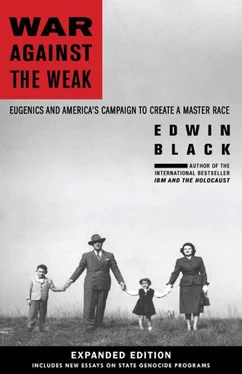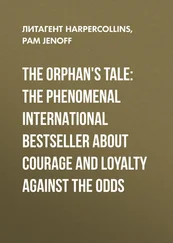Edwin Black - War Against the Weak
Здесь есть возможность читать онлайн «Edwin Black - War Against the Weak» весь текст электронной книги совершенно бесплатно (целиком полную версию без сокращений). В некоторых случаях можно слушать аудио, скачать через торрент в формате fb2 и присутствует краткое содержание. Город: Washington, DC, Год выпуска: 2012, ISBN: 2012, Издательство: Dialog Press, Жанр: История, на английском языке. Описание произведения, (предисловие) а так же отзывы посетителей доступны на портале библиотеки ЛибКат.
- Название:War Against the Weak
- Автор:
- Издательство:Dialog Press
- Жанр:
- Год:2012
- Город:Washington, DC
- ISBN:1-56858-258-7
- Рейтинг книги:3 / 5. Голосов: 2
-
Избранное:Добавить в избранное
- Отзывы:
-
Ваша оценка:
- 60
- 1
- 2
- 3
- 4
- 5
War Against the Weak: краткое содержание, описание и аннотация
Предлагаем к чтению аннотацию, описание, краткое содержание или предисловие (зависит от того, что написал сам автор книги «War Against the Weak»). Если вы не нашли необходимую информацию о книге — напишите в комментариях, мы постараемся отыскать её.
War Against the Weak — читать онлайн бесплатно полную книгу (весь текст) целиком
Ниже представлен текст книги, разбитый по страницам. Система сохранения места последней прочитанной страницы, позволяет с удобством читать онлайн бесплатно книгу «War Against the Weak», без необходимости каждый раз заново искать на чём Вы остановились. Поставьте закладку, и сможете в любой момент перейти на страницу, на которой закончили чтение.
Интервал:
Закладка:
Today we are faced with a potential return to eugenic discrimination, not under national flags or political credos, but as a function of human genomic science and corporate globalization. Shrill declarations of racial dominance are being replaced by polished PR campaigns and patent protections. What eugenics was unable to accomplish in a century, newgenics may engineer in a generation. The almighty dollar may soon decide who stands on which side of a new genetic divide already being demarcated by the wealthy and powerful. As we speed toward a new biological horizon, confronting our eugenic past will help us confront the bewildering newgenic future that awaits.
I first became interested in eugenics while researching my previous books, The Transfer Agreement and IBM and the Holocaust. The Transfer Agreement, published in 1984, documented the tempestuous worldwide anti-Nazi boycott, which included vigorous efforts to stop American organizations from funding medical research. At the time I could not understand why Nazi medical research was so important to American corporate philanthropists. The scope of eugenics escaped me. Then in 2000, while researching IBM and the Holocaust-which revealed IBM’s role in automating Germany’s eugenic institutions-I finally came to see that eugenics was a life and death proposition for Europe’s Jews. Yet I still didn’t realize that this bizarre cult of Nazi race science was organically linked to America.
As I explored the history of eugenics, however, I soon discovered that the Nazi principle of Nordic superiority was not hatched in the Third Reich but on Long Island decades earlier-and then actively transplanted to Germany. How did it happen? Who was involved? To uncover the story I did as I have done before and launched an international investigation. This time, a network of dozens of researchers, mostly volunteers, working in the United States, England, Germany and Canada unearthed some 50,000 documents and period publications from more than forty archives, dozens of library special collections and other repositories (see Major Sources). But unlike the Holocaust field, in which the documentation is centralized in a number of key archives, the information on eugenics is exceedingly decentralized and buried deep within numerous local and niche repositories.
In the United States alone, the investigation brought my team to the archival holdings of the American Philosophical Society in Philadelphia, to the Cold Spring Harbor Laboratory on Long Island, to Truman State University in northeastern Missouri, to numerous obscure community colleges in the Appalachian states, and a long list of state archives, county historical files and institutional archives where personal papers and period materials are stored. I also spent much time in many small, private libraries and archives, such as the one maintained by Planned Parenthood. We examined records at the Rockefeller Foundation and the Carnegie Institution. There are probably two hundred important repositories in America, many of them special collections and manuscript departments of local libraries or universities. Because eugenics was administered on the local level, every state probably possesses three to five sites hosting important eugenic documentation. I only accessed a few dozen of these across America. Much more needs to be done and American researchers will surely be kept busy for a decade mining the information.
In England I visited the British Library, the Wellcome Library, the University College of London, the Public Record Office and other key archives. These not only provided the information on Britain’s eugenic campaigns, but also yielded copies of correspondence with American eugenic organizations that are simply not available in the American holdings. For example, strident propaganda pamphlets long cleansed from American files are still stored in the British records.
Because the German and American wings collaborated so closely, the German archives clearly traced the development of German race hygiene as it emulated the American program. More importantly, because the American and German movements functioned as a binary, their leaders bragged to one another and exchanged information constantly. Therefore I learned much about America’s record by examining Reich-era files. For instance, although the number of individuals sterilized in Vermont has eluded researchers in that state, the information is readily available in the files of Nazi organizations. Moreover, obscure Nazi medical literature reveals the Nazis’ understanding of their American parmers. Probing the prodigious files of Nazi eugenics took my project to the Bundesarchiv in Berlin and Koblenz, the Max Planck Institute in Berlin, Heidelberg University and many other repositories in Germany.
When it was finished, the journey to discover America’s eugenic history had taken me from an austere highway warehouse in Vermont, where the state’s official files are stacked right next to automotive supplies and retrieved by forklift, to the architectonic British Library, to the massive Bundesarchiv in Berlin-and every type of research environment in between. Sometimes I sat on a chair in a reading room. Sometimes I poked through boxes in a basement.
Even still, I was not prepared for the many profound built-in challenges to eugenic research. My experiences are rooted in Holocaust investigation, where a well-developed infrastructure is in place. Not so with eugenics. In Holocaust research, archives facilitate unlimited speedy photocopying of documents. The Public Record Office in London produces copies within hours. The National Archives in Washington, D.C., allows self-service photocopying. But the most important eugenic archive in Britain, storing thousands of important documents, limits users to just one hundred copies per year. America’s largest eugenic archive, housing vast numbers of papers in numerous collections, limits researchers to just four hundred copies per year. Often the beleaguered and understaffed copy departments in these archives needed between three and four weeks to produce the copies. One archive asked for three months to copy a ten-page document. Fortunately, I was able to circumvent these restrictions by deploying teams of five and ten researchers at these archives, and by virtue of the gracious and indispensable flexibility of archivists who continuously assisted me in this massive project (see Acknowledgments). Only by their special efforts and indulgence was I able to secure as many as five thousand copies from a single archive, and reasonably quickly-thus allowing me to gain a comprehensive view of the topic and shorten my work by years.
Another profound obstacle has been the fallacious claim by many document custodians, in both state and private archives, that the records of those sterilized, incarcerated and otherwise manipulated by the eugenics movement are somehow protected under doctor-patient confidentiality stretching back fifty to one hundred years. This notion is a sham that only dignifies the crime. Legislation is needed to dismantle such restrictions. No researcher should ever accept assertions by any document custodian that such records are covered by confidentiality protections accorded to medical procedures-whether in Nazi Germany or the United States. The people persecuted by eugenics were not patients, they were victims. No doctor-patient relationship was established. Most of the unfortunate souls snared by eugenics were deceived and seized upon by animal breeders, biologists, anthropologists, raceologists and bureaucrats masquerading as medical men. Mengele’s victims were not patients. Nor were those in America who were caught up in the fraudulent science of eugenics.
In some instances, records were initially denied to me on this basis. Fortunately, the investigative reporter only gets started when he hears the word no. I demanded full access and was grateful when I received it. I applaud the State of Virginia for allowing me to be the first to receive files on the infamous sterilization of Carrie Buck; copies of those files are now in my office.
Читать дальшеИнтервал:
Закладка:
Похожие книги на «War Against the Weak»
Представляем Вашему вниманию похожие книги на «War Against the Weak» списком для выбора. Мы отобрали схожую по названию и смыслу литературу в надежде предоставить читателям больше вариантов отыскать новые, интересные, ещё непрочитанные произведения.
Обсуждение, отзывы о книге «War Against the Weak» и просто собственные мнения читателей. Оставьте ваши комментарии, напишите, что Вы думаете о произведении, его смысле или главных героях. Укажите что конкретно понравилось, а что нет, и почему Вы так считаете.












